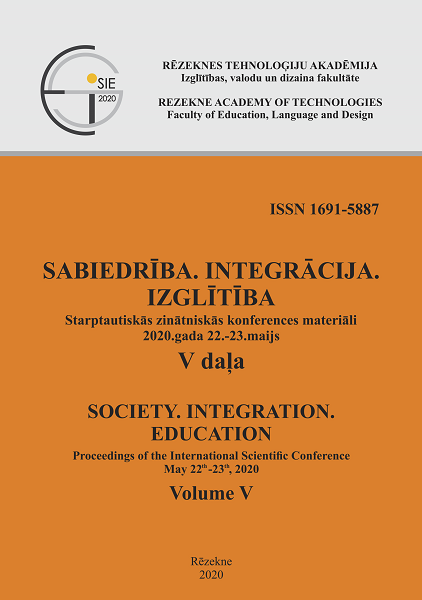ARTS THERAPIES IN LIFELONG LEARNING – OPPORTUNITIES AND SOLUTIONS
DOI:
https://doi.org/10.17770/sie2020vol5.5092Keywords:
adult educator, andragogy, arts therapies, art therapist, broad skills, lifelong learningAbstract
Observing lifelong learning programs in Latvia, there is a tendency to develop study courses that ensure the acquisition of new professional knowledge and skills, as well as their development, but a very minor section of courses and programs is devoted to the personality, resources, needs and acquisition of broad skills involved in adult education.
In professional and scientific literature there is no reflection of the research conducted so far in Latvia on the use of arts therapies in maintaining the quality of life of adults in the context of lifelong learning.
Purpose of the article: to research education as one of the indicators of quality of life in Europe and Latvia and differences and similarities in andragogy and arts therapies in order to get an idea of the possibilities of using arts therapies in lifelong learning.
Method: content analysis of pedagogical and psychological literature, scientific articles, data of Eurostat population quality of life surveys, as well as official EU and Republic of Latvia guidelines on quality of life and lifelong learning issues.
Results: the professional and personal competencies of an adult educator and an art therapist are highly demanding and have a number of common features. An adult educator and an art therapist have similar professional tasks - to see the needs of those involved in adult education and arts therapies, to support individual self-development, to encourage personality development, thus improving the quality of life. For each specialisation of arts therapies (music, dance and movement, drama and visual plastic) a specific application can be made according to target groups, educational stage and programs, as well as areas of needs.
Downloads
References
Brookfield, S.D. (1986). Understanding and Facilitating Adult Learning. Buckingham: Open University Press.
Eurofound. (2019). Subjective well–being. Retrieved from https://www.eurofound.europa.eu/lv/topic/subjective-well-being
Eurostat. (2019). About one third. Retrieved from https://ec.europa.eu/eurostat/statistics-explained/index.php?title=Quality_of_life_indicators_-_education#About_one_third_of_those_aged_25-64_had_a_tertiary_degree_in_2017
Eurostat. (2019a). Education in the context of quality of life. Retrieved from https://ec.europa.eu/eurostat/statistics-explained/index.php?title=Quality_of_life_indicators_-_education#Education_in_the_context_of_quality_of_life
Eurostat. (2019b). Glossary: Lifelong learning. Retrieved from https://ec.europa.eu/eurostat/statistics-explained/index.php?title=Glossary:Lifelong_learning
Eurostat. (2019c). Quality of life indicators – education. Retrieved from https://ec.europa.eu/eurostat/statistics-explained/index.php?title=Quality_of_life_indicators_-_education
Eurostat. (2019d). 10.9 % of those aged 25–64. Retrieved from https://ec.europa.eu/eurostat/statistics-explained/index.php?title=Quality_of_life_indicators_-_education#C2.A0.25_of_those_aged_25-64_attended_training_in_last_4_weeks
Ivanova, I. (2016). Pieaugušo mācīšanās īpatnības. Retrieved from https://ec.europa.eu/epale/lv/resource-centre/content/pieauguso-macisanas-ipatnibas
Knowles, M.S. (1973). The Adult Learner: A Neglected Species. Houston: Gulf Publishing Company.
Knowles, M.S. (1980). The Modern Practice of Adult Education: from Pedagogy to Andragogy. (2nd ed.). New York: Cambridge Books.
Koķe, T. (1999). Pieaugušo izglītības attīstība: raksturīgākās iezīmes. Rīga: SIA “Mācību apgāds NT”.
Kolb, D. A. (1984). Experiential learning: experience as the source of learning and development. Englewood Cliffs, NJ: Prentice Hall.
Krevica, E. (2011). Psiholoģijas un psihoterapijas ietekmes mākslu terapijā. In No K. Mārtinsone (sast.), Mākslu terapija (76 – 105). Rīga: Raka.
Lieģeniece, D. (2002). Ievads andragoģijā jeb mācīšanās “būt” pieaugušo vecumā. Rīga: Raka.
Majore – Dūšele, I. (2011). Mākslas terapeita kompetences. In K. Mārtinsone (sast.), Mākslu terapija (184 – 197). Rīga: Raka.
Mārtinsone, M., Mihailovs, I.J., & Vāverniece, I. (2010). Māksla, terapeitiskā māksla, mākslas izglītība, mākslu terapija – mākslu metodes un tehnikas profesionālajā darbībā: jēdzieni, atšķirības, atbildība. In K. Mārtinsone (sast.), Mākslu metodes un tehnikas profesionālajā darbībā (9 – 21). Rīga: Raka.
Skujiņa, V. (autoru kol. vad.) (2000). Pedagoģijas terminu skaidrojošā vārdnīca. Rīga: Zvaigzne ABC.
Upmale, A., & Majore – Dūšele, I. (2011). Mākslu terapijas procesa raksturojums: integratīvi eklektiskā pieeja. In K. Mārtinsone (sast.), Mākslu terapija (106 –183). Rīga: Raka.
Zālīte, R. (2010). Multimodālā pieeja. In K. Mārtinsone (sast.), Mākslu metodes un tehnikas profesionālajā darbībā (186 – 209). Rīga: Raka.
Zālīte, R. (2010a). Radošais potenciāls un cilvēka resursi. In K. Mārtinsone (sast.), Mākslu metodes un tehnikas profesionālajā darbībā (22 – 29). Rīga: Raka.


